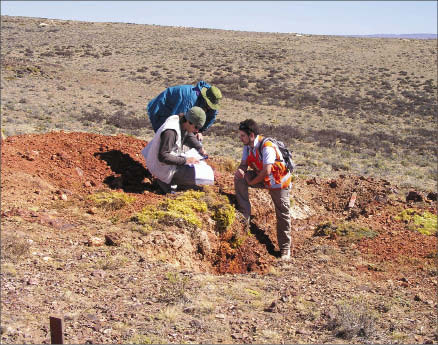Until late 2009, Argentex Mining (ATX-V, AGXM-O) focused on drilling the polymetallic sulphide mineralization at its Pinguino project in Argentina. But then the company decided to shift gears and focus instead on the property’s near-surface silver-gold oxide horizon.
Now results of a preliminary economic assessment (PEA) on the near-surface zone suggest that the shallow oxidized mineralization can generate sufficient rates of return and cash flow to support continued mine development and resource expansion, the company says.
The PEA covers only nine of the 51 individual mineralized veins identified so far at Pinguino. The nine veins represent about 7 line km of Pinguino’s estimated total strike length of more than 75 line km, the company says. The PEA also does not include exploration data from 2010.
Using a base case of US$1,036 per oz. gold and US$16.96 per oz. silver, Pinguino would yield an internal rate of return of 44% over a mine life of eight years, with net cash flow of US$29.7 million, a net present value at a 5% discount rate of US$21.9 million, and payback of less than two years. Average annual production is estimated at 657,000 oz. silver and 6,400 oz. gold and the capital costs to build the mine would be around US$20.7 million.
The PEA assumes an open-pit mine with a 3,000-tonne-per-day heap-leach operation from the oxide portion of the deposit and would produce a silver-gold doré onsite.
The Pinguino property has two categories of mineralization. The first is a thick horizon of oxide material, enriched in silver and gold, within the first 50 metres of surface. Below that oxide material, there is a layer of unoxidized mineralization from about 50 metres below surface to a tested depth of 400 metres. The primary material comprises quartz-rich silver-gold as well as sulphide-rich polymetallic mineralization, the company says.
The polymetallic mineralization has been found within multiple veins of up to 10 metres in width and “extensive” strike lengths, the company reports. Argentex believes the veins are open in all directions and have potential for expansion.
Pinguino’s indium-enriched base metal mineralization represents a new deposit type for Patagonia, the company says, and it believes the property has one of Santa Cruz province’s largest base metal and epithermal silver-gold systems.
This year’s 17,000-metre drill program is well underway and will test high-grade silver targets that the company pinpointed last year. Argentex has already completed 6,300 metres of the drill program.
Among the targets being tested are the Tranquilo and Luna veins, which returned high-grade results in previous drill programs including 6 metres of more than 2,400 grams silver per tonne and 0.22 gram gold per tonne, and 6.4 metres of 486.6 grams silver and 1.91 grams gold.
At presstime in Toronto, Argentex was trading at $1.15 per share and has traded between 45¢ per share (Aug. 20, 2010) and $1.20 per share (March 11, 2011).
The junior explorer has about 44.7 million shares outstanding.


Be the first to comment on "Argentex posts Pinguino PEA"